Blog

Constantin Brancusi, The Golden Bird Year, c. 1919-22, Gelatin silver print
In other images Brancusi underscores his attachment to his works as almost living spirits, multiplying and animating their forms with shadows or double exposures, or arranging them in suggestive tableaus. In an especially tender image his sculpture “Little French Girl†seems to sidle up to a cuplike sculpture resting on an “Endless Column†fragment as if this combination were a comforting parent.
—“From Roberta Smith’s NYTÂ review on Brancusi’s show at Bruce Silverstein until June 23. Don’t miss it.
Jun 13, 2012 | Categories: Creative Culture, New York City | Comments Off on Constantin Brancusi, The Golden Bird
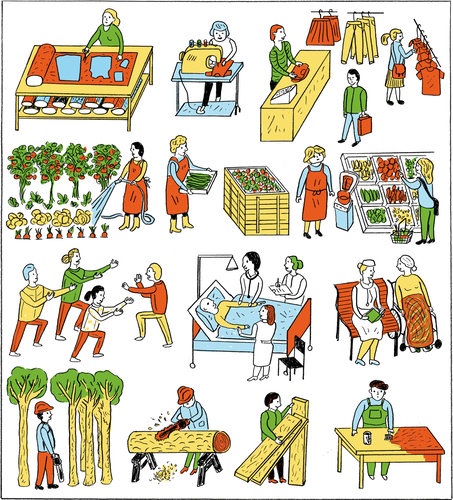
An interesting article in the NYT recently argues that we’re “hooked on growth.” An excerpt:
At first, this may sound crazy; we’ve become so conditioned by the language of efficiency. But there are sectors of the economy where chasing productivity growth doesn’t make sense at all. Certain kinds of tasks rely inherently on the allocation of people’s time and attention. The caring professions are a good example: medicine, social work, education. Expanding our economies in these directions has all sorts of advantages.
In the first place, the time spent by these professions directly improves the quality of our lives. Making them more and more efficient is not, after a certain point, actually desirable. What sense does it make to ask our teachers to teach ever bigger classes? Our doctors to treat more and more patients per hour? The Royal College of Nursing in Britain warned recently that front-line staff members in the National Health Service are now being “stretched to breaking point,” in the wake of staffing cuts, while a study earlier this year in the Journal of Professional Nursing revealed a worrying decline in empathy among student nurses coping with time targets and efficiency pressures. Instead of imposing meaningless productivity targets, we should be aiming to enhance and protect not only the value of the care but also the experience of the caregiver.
The care and concern of one human being for another is a peculiar “commodity.” It can’t be stockpiled. It becomes degraded through trade. It isn’t delivered by machines. Its quality rests entirely on the attention paid by one person to another. Even to speak of reducing the time involved is to misunderstand its value.
Care is not the only profession deserving renewed attention as a source of economic employment. Craft is another. It is the accuracy and detail inherent in crafted goods that endows them with lasting value. It is the time and attention paid by the carpenter, the seamstress and the tailor that makes this detail possible. The same is true of the cultural sector: it is the time spent practicing, rehearsing and performing that gives music, for instance, its enduring appeal. What—aside from meaningless noise—would be gained by asking the New York Philharmonic to play Beethoven’s Ninth Symphony faster and faster each year?
Jun 11, 2012 | Categories: Sustainability | Comments Off on Tim Jackson: “Let’s Be Less Productive”
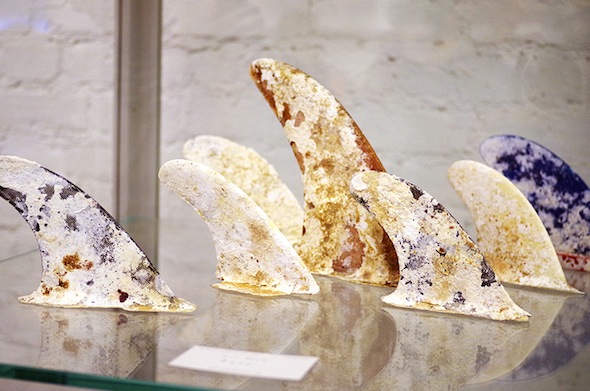
Partners & Spade, a shop in New York City, regularly hosts exhibitions. “M.Nii” has just opened, featuring found pieces and art by Mark Cunningham. It’s all about the culture of surfing, and features surfboard fins, vintage surf books, barnacled watches, swim trunks, and the like. See more pictures at the blog The Fox Is Black, or visit the Partners & Spade website.
Jun 09, 2012 | Categories: New York City, Surfing | Comments Off on M.Nii at Partners & Spade, New York
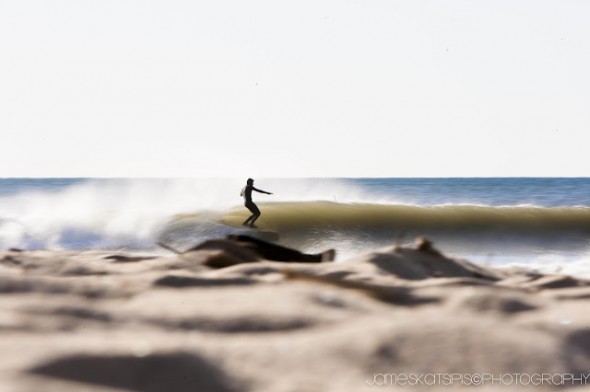 Weekends are way more fun now that summer’s here! Images by Montuak photographer, James Katsipis.
Weekends are way more fun now that summer’s here! Images by Montuak photographer, James Katsipis. 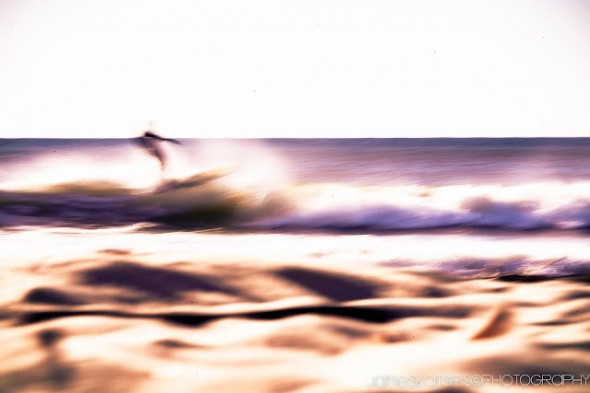
Jun 08, 2012 | Categories: Creative Culture, Surfing | Comments Off on James Katsipis

Detail view of the book's front cover
Carl Safina, a MacArthur Foundation “Genius Grant”–winning ocean scientist, recently published The View from Lazy Point, a lyrical, evocative, and humane story of mankind’s relationship with nature. The book opens with fifty pages describing the change from winter to spring at Safina’s home on the North Fork of Long Island, then continues with journeys in the four cardinal directions. Each encounter Safina has—whether with plants, animals, or humans—builds upon his fundamental point: “Every advance in thinking has shown that our relationships extend further than we thought.” Recognizing the radical nature of this thought, and behaving accordingly, is the elusive goal he seeks.
Click here to read more about the book on the author’s website.
Jun 07, 2012 | Categories: Sustainability | Tags: environmentalism, oceans, science | Comments Off on Carl Safina’s “The View from Lazy Point”
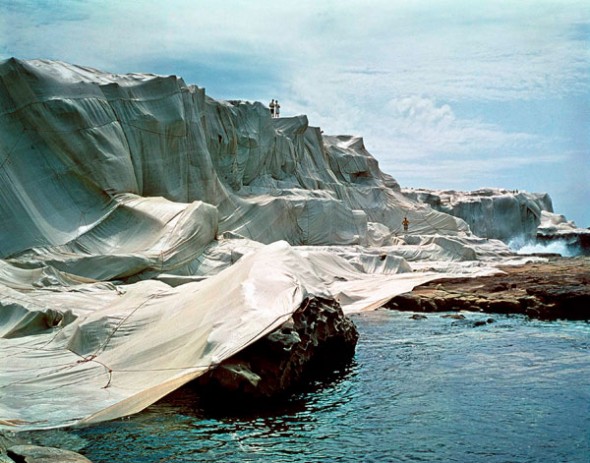
Jeanne-Claude and Christo, Wrapped Coast-One Million Square Feet. 1968-96
Ends of the Earth: Land Art to 1974 is the first large-scale, historical-thematic exhibition to deal broadly with Land art, capturing the simultaneous impulse emergent in the 1960s to use the earth as an artistic medium and to locate works in remote sites far from familiar art contexts. Organized by MOCA Senior Curator Philipp Kaiser and co-curator Miwon Kwon, Professor of Art History at UCLA, the exhibition highlights the early years of untested artistic experimentations and concludes in the mid-1970s before Land art becomes a fully institutionalized category. Rather than romanticizing notions of “return to nature” or an “escape from culture”, the exhibition provides a comprehensive overview that reveals the complexity of the movement’s social and political engagement with the historical conditions of its time. Ends of the Earth exposes Land art as a media practice as much as a sculptural one, focusing on the extent to which language, photography, film, and television served as an integral and not a secondary or supplementary part of its formation. Over eighty artists and projects from United Kingdom, Japan, Israel, Iceland, Eastern and Northern Europe, as well as North and South Americas are included in the show.Â
On view until September 3 at MoCA!
Jun 07, 2012 | Categories: Creative Culture, Nature | Comments Off on “Ends of the Earth: Land Art to 1974”
Jun 06, 2012 | Categories: Creative Culture | Comments Off on Paul Thomas Anderson’s Excellent Trailer for The Master
 New York City’s massive new bike share program is inching ever closer to its July debut. To that end, the city has announced not only the name of the program’s $41 million sponsor (Citibank) but also the program’s official name (CitiBike, of course) and, most important of all, the exact pricing for the program. And if you were thinking of joining up in order to go on bicycle weekend trips to City Island…sounds like you’ll be better off just buying your own bike. When they say these bikes are meant for short three miles-ish trips, they mean it—the system gives members unlimited free rides for short trips, but the pricing skyrockets as sand falls through the hourglass. Read more from the Gothamist here.
New York City’s massive new bike share program is inching ever closer to its July debut. To that end, the city has announced not only the name of the program’s $41 million sponsor (Citibank) but also the program’s official name (CitiBike, of course) and, most important of all, the exact pricing for the program. And if you were thinking of joining up in order to go on bicycle weekend trips to City Island…sounds like you’ll be better off just buying your own bike. When they say these bikes are meant for short three miles-ish trips, they mean it—the system gives members unlimited free rides for short trips, but the pricing skyrockets as sand falls through the hourglass. Read more from the Gothamist here.
Jun 05, 2012 | Categories: New York City, Sustainability | Comments Off on Countdown to Bike Sharing in NYC




 Weekends are way more fun now that summer’s here! Images by Montuak photographer,
Weekends are way more fun now that summer’s here! Images by Montuak photographer,


 New York City’s massive newÂ
New York City’s massive new 


